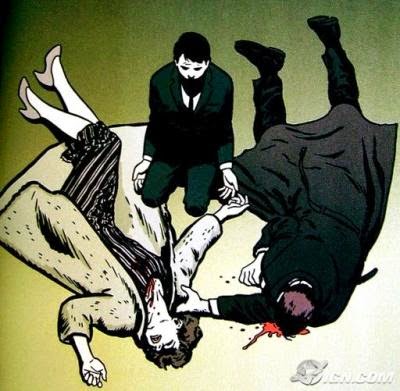 |
| Batman finally kills the Joker in the future-set Dark Knight Returns (1986) |
The public’s appetite for action and
violence grew at an immense rate in the 1980s and this was immediately
reflected in the pages of Batman.
While action blockbusters like Rambo
(1985) and The Terminator (1983) pummeled
the competition at the box-office and video games rose to new levels of
sophistication and gore, Batman forever changed in 1986 with the release of
the aforementioned The Dark Knight Returns. Set in the near future, The Dark Knight Returns featured a world
on the brink of nuclear war, the murder of the Joker at the hands of Batman
himself and a final showdown to the death between former friends Bruce Wayne
and Clark Kent a.k.a. Superman.
These events fed the cravings of the waiting public as sales skyrocketed
for publisher DC Comics. These visions of doom and destruction met
the hopes of the 80s video-game enhanced audience who craved the violence and
action. Later in 1988, DC Comics
released A
Death in the Family. This storyline absolutely captured the will of the
audience as DC left the fate of Robin up to the
general public. DC posted 900
line phone numbers that allowed readers to vote whether of not Robin died within
the pages of the story. The public gave a majority vote for
Robin to die and that death came at the hands of an extremely violent Joker,
beating the life out him with a bloody iron crowbar. This marks the wish of the public to see the death of an
iconic character. This interest the audience for a new experience like Robin’s
death parallels the experience in video games of the era, always exploding with
new imagery and sounds. This violence-filled, distrustful world of Batman
endures to this day.
 |
| Robin (Jason Todd) is murdered by the Joker |
On the big screen,
Batman became a movie icon. The
public’s adoration for this character reflects easily in the hundreds of
billions of dollars in revenue generated by the seven movies released since 1989. The last movie, Christopher Nolan’s The Dark Knight Rises, made over 100
billion dollars alone. As dvd sales of the movies continue to
this day, the familiar image of the cape and cowl became immediately
recognizable as Batman, the icon.
The changing desires of the audience
brought forth this evolved version of Batman and his violent ways. While not
the will of all people, the violent display of the Aurora, Colorado theater
shooting during the premiere of The Dark
Knight Rises shows a testament to the times we live in. This somewhat crossover of the violence
of Batman into the real world shows that the will and madness exists but needs
to stay within the pages of the comic books. Batman truly became a dark
mirrored reflection of our society.














